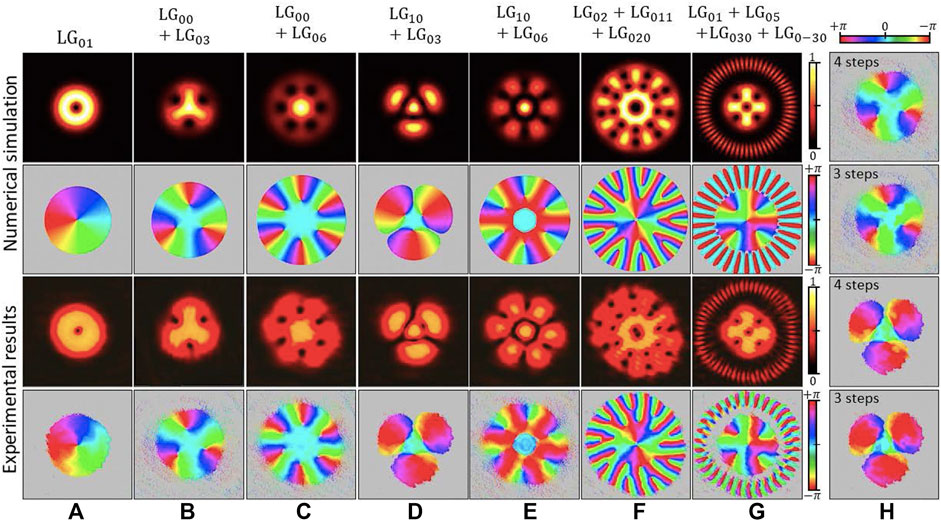 A new paper has been published in Frontiers in Physics entitled Phase-shifting common-path polarization self-interferometry for evaluating the reconstruction of holograms displayed on a phase-only display.
A new paper has been published in Frontiers in Physics entitled Phase-shifting common-path polarization self-interferometry for evaluating the reconstruction of holograms displayed on a phase-only display.
Here we demonstrate a technique to perform phase-shift interferometry of structured light. The interesting aspect is that the same SLM system used to generate the structured light is used, without no need of any additional element, to perform the phase-shift interferometry. A simple rotation of a polarizer transforms the system from the standard phase-modulation regime to the common-path polarization interferometer.
This paper is part of the PhD Thesis of Esther Nabadda.
 This year Esther Nabadda attended the 2022 Siegman International School on Lasers, a week-long program covers all aspects of lasers and photonics. This year the School was organized by the University of Warsaw at Checiny (Poland), from 25th June to 2nd July 2022.
This year Esther Nabadda attended the 2022 Siegman International School on Lasers, a week-long program covers all aspects of lasers and photonics. This year the School was organized by the University of Warsaw at Checiny (Poland), from 25th June to 2nd July 2022.
Esther attended the courses and presented her PhD work in progress entitled «Ferroelectric liquid crystal modulator with large switch rotation angle for polarization independent binary phase modulation»,work made in collaboration with Dr. Noureddine Bennis and his colleagues at the Military University of Technology of Warsaw.
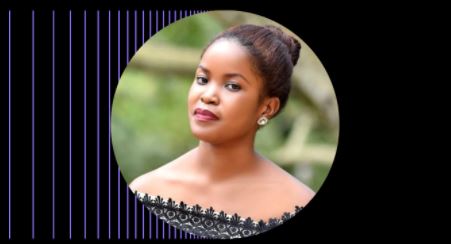
Esther appears on the section «Amplify Black Voices in Optics» of OPTICA (former OSA), a section devoted to meet scientists and engineers from all over the world who represent Black achievement in science at every stage of their careers.
More details: Amplify Black Voices in Optics | Living History | Optica
jueves, 23 de diciembre de 2021
i.moreno
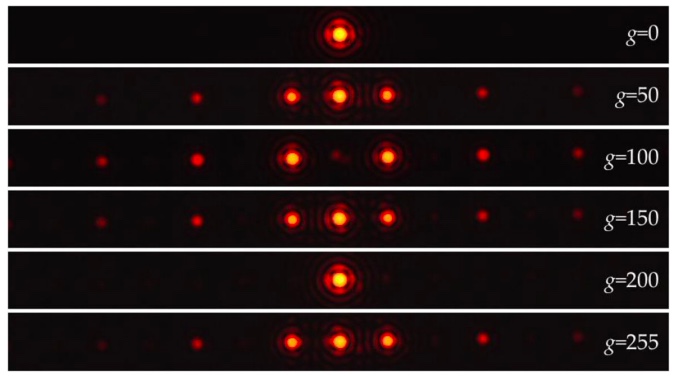 Our last work is published in the Journal of the European Optical Society – Rapid Publications, entitled Simple method to evaluate the pixel crosstalk caused by fringing field effect in liquid-crystal spatial light modulators.
Our last work is published in the Journal of the European Optical Society – Rapid Publications, entitled Simple method to evaluate the pixel crosstalk caused by fringing field effect in liquid-crystal spatial light modulators.
The technique is a reverse engineering method that does not require information about the microscopic physical parameters of the liquid-crystal material or details of the fabrication and electronics of the display. Instead, it is based on the overall effect on the diffraction efficiency of displayed binary phase gratings as a function of the addressed gray level. We show how the efficiency of the zero (DC) and first diffraction orders provides valuable information enough to identify and quantify the pixel crosstalk. The technique is demonstrated with a modern phase-only liquid-crystal on silicon (LCOS) spatial light modulator (SLM), illustrating the limitations that this effect imposes to the spatial resolution of the device and providing quantitative measurement of the impact on the diffraction efficiency.
The work has been done in collaboration with our colleagues Prof. Jeffrey A. Davis and Prof. Don M. Cottrell from San Diego State University.
domingo, 19 de diciembre de 2021
i.moreno

Esther Nabadda completed a research stay at the Faculty of Advanced Technology and Chemistry of the Military University of Technology (WAT), in Warsaw. This stay is part of her PhD program and there she has been learning techniques for the production and characterization of different liquid-crystal optical modulators, under the supervision of Dr. hab Noureddine Bennis.
This stay was performed within the frame of the project NAWA PROM – «International scholarship exchange of doctoral candidates and academic staff» implemented at WAT.
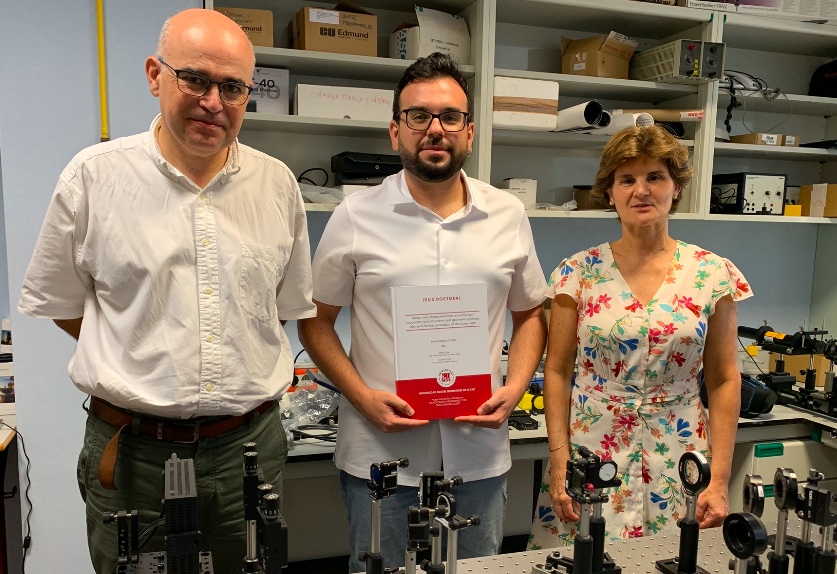 David Marco completed his PhD studies with a public defense of his PhD Thesis entitled «Design and characterization of spatial light modulator optical systems and geometrical phase elements for the generation of structured light«, supervised by María del Mar Sánchez-Lopez and Ignacio Moreno.
David Marco completed his PhD studies with a public defense of his PhD Thesis entitled «Design and characterization of spatial light modulator optical systems and geometrical phase elements for the generation of structured light«, supervised by María del Mar Sánchez-Lopez and Ignacio Moreno.
The Thesis has been developed at TECNIT – the Doctoral Program on Industrial and Telecommunications Technologies at UMH.
The jury for the defense was composed by Dr. Gemma Piquero, from University Complutense of Madrid, Dr. Carlos Hernández, from University of Salamanca and Dr. Carlos R. Fernández-Pousa, from UMH.
miércoles, 1 de septiembre de 2021
i.moreno
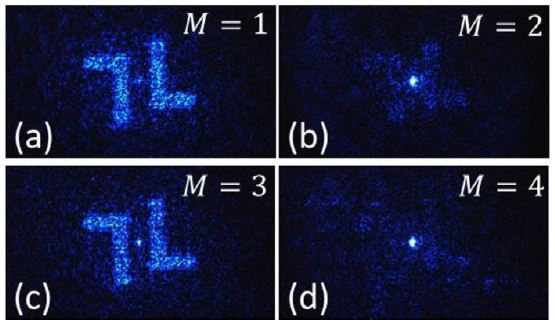 Our last work is published in the journal Optics & Lasers in Engineering, entitled Multiple-order correlations and convolutions using a spatial light modulator with extended phase range. Here we present a new type of optical convolver / optical correlator capable of encoding multiple such operations. The technique is based on obtaining higher powers of a properly designed hologram. This can be obtained in two ways. First, we can recalculate higher powers of the amplitude and phase hologram in a standard spatial light modulator (SLM). Alternatively, we can utilize a phase-only hologram and exploit the properties of an SLM with extended phase modulation range.
Our last work is published in the journal Optics & Lasers in Engineering, entitled Multiple-order correlations and convolutions using a spatial light modulator with extended phase range. Here we present a new type of optical convolver / optical correlator capable of encoding multiple such operations. The technique is based on obtaining higher powers of a properly designed hologram. This can be obtained in two ways. First, we can recalculate higher powers of the amplitude and phase hologram in a standard spatial light modulator (SLM). Alternatively, we can utilize a phase-only hologram and exploit the properties of an SLM with extended phase modulation range.
The work has been done in collaboration with our colleagues Prof. Jeffrey A. Davis and Prof. Don M. Cottrell, and with Benjamin Gutierrez, from San Diego State University.
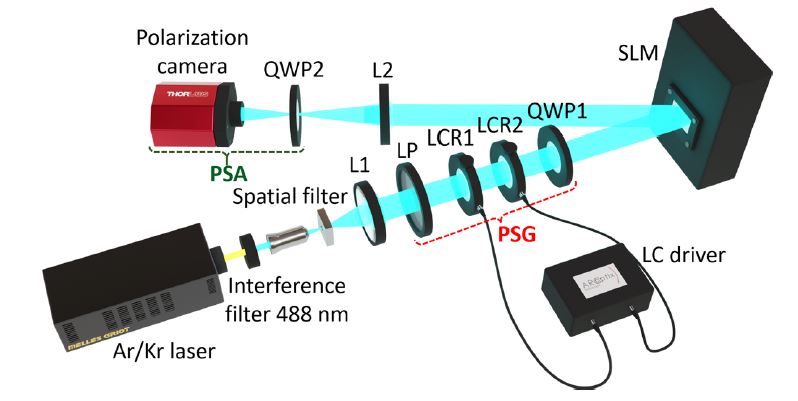 In our recent paper in Scientific Reports entitled Customized depolarization spatial patterns with dynamic retardance functions we demonstrate a proof-of-concept of a dynamical time-dependent pixelated retarder used to emulate a controlled spatially variant depolarizing sample.
In our recent paper in Scientific Reports entitled Customized depolarization spatial patterns with dynamic retardance functions we demonstrate a proof-of-concept of a dynamical time-dependent pixelated retarder used to emulate a controlled spatially variant depolarizing sample.
We apply an imaging Mueller polarimetric system based on a polarization camera to verify the effective depolarization effect, and the effective depolarizance results are fully described within a simple graphical approach and standard Mueller matrix decomposition methods. The technique is illustrated by means of three practical cases, including exotic structures as a spirally shaped depolarization pattern.
The work has been done in collaboration with our colleagues Angel Lizana and Juan Campos, from MIP Optilab Laboratory at the Department of Physics of Universitat Autònoma de Barcelona, in the frame of our common research project devoted to the development of advanced polarimetric systems.
This work is also part of the PhD Thesis of David Marco.
 A new paper is available at the journal Frontiers in Physics entitled Programmable supercontinuum laser spectrum generator based on a liquid-crystal on silicon spatial light modulator.
A new paper is available at the journal Frontiers in Physics entitled Programmable supercontinuum laser spectrum generator based on a liquid-crystal on silicon spatial light modulator.
In this work we present an optical system to spectrally filter a supercontinuum (SC) laser using liquid-crystal on silicon SLMs. The proposed optical system disperses the input laser and the spectrally separated components are projected onto the LCoS-SLM, where the state of polarization of each wavelength is separately modulated. Finally, recombining the modulated spectral components results in an output laser source where the spectrum can be controlled dynamically from a computer. The system incorporates two branches to independently control the visible (VIS) and the near infrared (NIR) spectral content, thus providing a SC laser source from 450 nm to 1600 nm with programmable spectrum.
We expect this new ability for controlling at will the wide spectra of the SC laser sources can be extremely useful for biological imaging applications.
This work was done with our former Master students Jordi Gomis and Pedro Martínez, and with Dr. Aarón Cofre after completing his PhD Thesis.
 David Marco stayed for one month at ALBA synchrotron, where he collaborated in the implementation and calibration of a liquid-crystal on silicon spatial light modulator, to be used in a fluorescence microscope in one of the lines of ALBA.
David Marco stayed for one month at ALBA synchrotron, where he collaborated in the implementation and calibration of a liquid-crystal on silicon spatial light modulator, to be used in a fluorescence microscope in one of the lines of ALBA.
David has worked with experienced reserchers of ALBA, Eva Pereiro, Dominique Heinis and Josep Nicolás.
This stay was performed within the frame of our common national research project, coordinated by Prof. Juan Campos at Universitat Autònoma de Barcelona (UAB). This project involves the Optical Metrology & Image Processing Laboratory (MIP-OptiLab), the ALBA – Laboratory of Optics and TecnOPTO Laboratory.
This stay is also part of David’s training and research development within his PhD Thesis in the TECNIT PhD Program at UMH.
 A new paper has been published in Frontiers in Physics entitled Phase-shifting common-path polarization self-interferometry for evaluating the reconstruction of holograms displayed on a phase-only display.
A new paper has been published in Frontiers in Physics entitled Phase-shifting common-path polarization self-interferometry for evaluating the reconstruction of holograms displayed on a phase-only display.







